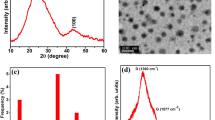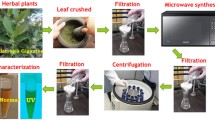Abstract
In this work, water dispersible fluorescent carbon nanocrystals (NCs) were synthesized by a simple, green and low cost hydrothermal method using Syzygium cumini (jamun) as a carbon source at 180 °C for 6 h. The average size of carbon NCs was found to be 2.1 ± 0.5 nm and shown bright blue fluorescence when excited at 365 nm under UV lamp. The carbon NCs were characterized by spectroscopic (UV-visible and fluorescence, Fourier transform infrared and dynamic light scattering) and high resolution transmission electron microscopic techniques. The quantum yield of carbon NCs was found to be ~5.9 % at 438 nm emission wavelength when excited at 360 nm. It was noticed that none of the metal ions quenched the fluorescence intensity of carbon NCs at 438 nm except for Fe3+, indicating the formation of Fe3+ ion-carbon NCs complexes. The linear range was observed in the concentration range of 0.01–100 μM with the corresponding detection limits of 0.001 μM, respectively. Furthermore, the carbon NCs were used as probes for imaging of fungal (Fusarium avenaceum) cells.






Similar content being viewed by others
References
Yang ST, Wang X, Wang H, Lu F, Luo PG, Cao L, Meziani MJ, Liu JH, Liu Y, Chen M (2009) Carbon dots as nontoxic and high-performance fluorescence imaging agents. Phys Chem C 113:18110–18114
Fowley C, McCaughan B, Devlin A, Yildiz I, Raymo FM, Callan JF (2012) Highly luminescent biocompatible carbon quantum dots by encapsulation with an amphiphilic polymer. Chem Commun 48:9361–9363
Baker SN, Baker GA (2010) Luminescent carbon nanodots: emergent nanolights. Chem Int Ed 49:6726–6744
Avouris P (2002) Molecular electronics with carbon nanotubes. Acc Chem Res 35:1026–1034
Javey A, Guo J, Wang Q, Lundstrom M, Dai H (2003) Ballistic carbon nanotube field-effect transistors. Nature 424:654–657
Liu H, Ye T, Mao C (2007) Fluorescent carbon nanoparticles derived from candle soot. Angew Chem Int Ed 46:6473–6475
Cao L, Wang X, Meziani MJ, Lu F, Wang H, Luo PG, Lin Y, Harruff BA, Veca LM, Murray D, Xie SY, Sun YP (2007) Carbon dots for multiphoton bioimaging. J Am Chem Soc 129:11318–11319
Yang ST, Cao L, Luo PGJ, Lu FS, Wang X, Wang HF, Meziani MJ, Liu YF, Qi G, Sun YP (2009) Carbon dots for optical imaging in vivo. J Am Chem Soc 131:11308–11309
Cao L, Sahu S, Parambath A, Bunker CE, Xu JA, Fernando KAS, Wang P, Guliants EA, Tackett KN, Sun YP (2011) Carbon nanoparticles as visible-light photocatalysts for efficient CO2 conversion beyond. J Am Chem Soc 133:4754–4757
Wang F, Chen YH, Liu CY, Ma DG (2011) White light-emitting devices based on carbon dots’ electroluminescence. Chem Commun 47:3502–3504
D'souza SL, Deshmukh B, Bhamore JR, Rawat KA, Lenka N, Kailasa SK (2016) Synthesis of fluorescent nitrogen-doped carbon dots from dried shrimps for cell imaging and boldine drug delivery system. RSC Adv 6:12169–12179
Ando Y, Zhao X, Kataura H, Achiba Y, Kaneto K, Tsuruta M, Uemura S, Iijima S (2000) Multiwalled carbon nanotubes prepared by hydrogen arc. Diam Relat Mater 9:847–851
Liu C, Zhao Z, Zhang R, Yang L, Wang Z, Yang J, Jiang H, Han MY, Liu B, Zhang Z (2015) Strong infrared laser ablation produces white-light-emitting materials via the formation of silicon and carbon dots in silica nanoparticles. J Phys Chem C 119:8266–8272
Hou Y, Lu Q, Wang H, Li H, Zhang Y, Zhang S (2016) One-pot electrochemical synthesis of carbon dots/TiO2nanocomposites with excellent visible light photocatalytic activity. Mater Lett 173:13–17
Duan J, Yu J, Feng S, Su L (2016) A rapid microwave synthesis of nitrogen-sulfur co-doped carbon nanodots as highly sensitive and selective fluorescence probes for ascorbic acid. Talanta 153:332–339
Prasannan A, Imae T (2013) One-pot synthesis of fluorescent carbon dots from orange waste peels. Ind Eng Chem Res 52:15673–15678
Wei J, Zhang X, Sheng Y, Shen J, Huang P, Guo S, Pan J, Feng B (2014) Dual functional carbon dots derived from corn flour via a simple one-pot hydro thermal route. Mater Lett 123:107–111
Sahu S, Behera B, Maitib TK, Mohapatra S (2012) Simple one-step synthesis of highly luminescent carbon dots from orange juice: application as excellent bio-imaging agents. Chem Commun 48:8835–8837
Dai H, Shi Y, Wang Y, Sun Y, Hu J, Ni P, Li Z (2014) A carbon dot based biosensor for melamine detection by fluorescence resonance energy transfer. Sensors Actuators B Chem 202:201–208
Pei S, Zhang J, Gao M, Wua D, Yang Y, Liu R (2015) A facile hydrothermal approach towards photoluminescent carbon dots from amino acids. J Colloid Interface Sci 439:129–133
Wang D, Wang X, Guo Y, Liu W, Qin W (2014) Luminescent properties of milk carbon dots and their Sulphur and nitrogen doped analogues. RSC Adv 4:51658–51665
Mehta VN, Jha S, Kailasa SK (2014) One-pot green synthesis of carbon dots by using Saccharum officinarum juice for fluorescent imaging of bacteria (Escherichia coli) and yeast (Saccharomyces cerevisiae) cells. Mater Sci Eng C 38:20–27
Mehta VN, Jha S, Singhal RK, Kailasa SK (2014) Preparation of multicolor emitting carbon dots for HeLa cell imaging. New J Chem 2014:6152–6160
Mehta VN, Jha S, Basu H, Singhal RK, Kailasa SK (2015) One-step hydrothermal approach to fabricate carbon dots from apple juice for imaging of mycobacterium and fungal cells. Sensors Actuators B Chem 2015:434–443
Braun V, Hantke K (2011) Recent insights into iron import by bacteria. Curr Opin Chem Biol 15:328–334
Goswami T, Rolfs A, Hediger MA (2002) Iron transport: emerging roles in health and disease. Biochem Cell Biol 80:679–689
Ghaedi M, Shokrollahi A, Kianfar AH, Mirsadeghi AS, Pourfarokhi A, Soylak M (2008) The determination of some heavy metals in food samples by flame atomic absorption spectrometry after their separation-preconcentration on bis salicyl aldehyde, 1,3 propan diimine (BSPDI) loaded on activated carbon. J Hazard Mater 154:128–134
Pomazal K, Prohaska C, Steffan I, Reich G, Huber JFK (1999) Determination of Cu, Fe, Mn, and Zn in blood fractions by SEC-HPLC-ICP-AES coupling. Analyst 124:657–663
Spolaor A, Vallelonga P, Gabrieli J, Cozzi G, Boutronf C, Barbante C (2012) Determination of Fe2+ and Fe3+ species by FIA-CRC-ICP-MS in Antarctic ice samples. J Anal At Spectrom 27:310–317
Yin BD, Deng JH, Peng X, Long Q, Zhao JN, Lu QJ, Chen Q, Tang H, Zhang YY, Yao SZ (2013) Green synthesis of carbon dots with down- and up-conversion fluorescent properties for sensitive detection of hypochlorite with a dual-readout assay. Analyst 138:6551–6557
Wang Q, Liu X, Zhang LC, Lv Y (2012) Microwave-assisted synthesis of carbon nanodots through an eggshell membrane and their fluorescent application. Analyst 137:5392
Yeh TY, Wang CI, Chang HT (2013) Photoluminescent C-dots@RGO for sensitive detection of hydrogen peroxide and glucose. Talanta 115:718–723
Mao Y, Bao Y, Han DX, Li FH, Niu L (2012) Efficient one-pot synthesis of molecularly imprinted silica nanospheres embedded carbon dots for fluorescent dopamine optosensing. Biosens Bioelectron 38:55–60
Miao P, Tang Y, Hanab K, Wang B (2015) Facile synthesis of carbon nanodots from ethanol and their application in ferric (III) ion assay. J Mater Chem A 3:15068–15073
Xu J, Zhou Y, Liu S, Dong M, Huang C (2014) Low-cost synthesis of carbon nanodots from natural products used as a fluorescent probe for the detection of ferrum(III) ions in lake water. Anal Methods 6:2086–2090
Yu J, Song N, Zhang YK, Zhong SX, Wang AJ, Chen J (2015) Green preparation of carbon dots by Jinhua bergamot for sensitive and selective fluorescent detection of Hg2+and Fe3+. Sensors Actuators B Chem 214:29–35
Yang X, Zhuo Y, Zhu S, Luo Y, Feng Y, Dou Y (2014) Novel and green synthesis of high-fluorescent carbon dots originated from honey for sensing and imaging. 60:292–298
Lakowicz JR (1999) Principles of fluorescence spectroscopy, 2nd edn. Kluwer Academic/Plenum Publishers, New York
Qin X, Lu W, Asiri AM, Al-Youbi AO, Sun X (2013) Microwave-assisted rapid green synthesis of photoluminescent carbon nanodots from flour and their applications for sensitive and selective detection of mercury(II) ions. Sensors Actuators B Chem 184:156–162
Mewada A, Pandey S, Shinde S, Mishra N, Oza G, Thakur M, Sharon M (2013) Green synthesis of biocompatible carbon dots using aqueous extract of T.Bispinosa peel. Mater Sci Eng C 33:2914–2917
Ju J, Chen W (2014) Synthesis of highly fluorescent nitrogen-doped graphene quantum dots for sensitive, label-free detection of Fe (III) in aqueous media. Biosens Bioelectron 58:219–225
Chen Z, Lu DT, Zhang GM, Yang J, Dong C, Shuang SM (2014) Glutathione capped silver nanoclusters-based fluorescent probe for highly sensitive detection of Fe3+. Sensors Actuators B Chem 202:631–637
Xu Q, Pu P, Zhao JG, Dong CB, Gao C, Chen YS, Chen JR, Liu Y, Zhou HJ (2015) Preparation of highly photoluminescent sulfur-doped carbon dots for Fe(III) detection. J Mater Chem A 3:542–546
Ananthanarayanan A, Wang XW, Routh P, Sana B, Lim S, Kim DH, Lim KH, Li J, Chen P (2014) Facile synthesis of graphene quantum dots from 3D graphene and their application for Fe3+ sensing. Adv Funct Mater 24:3021–3026
Wu SP, Chen YP, Sung YM (2011) Colorimetric detection of Fe3+ ions using pyrophosphate functionalized gold nanoparticles. Analyst 136:1887–1891
Han C, Wang R, Wang K, Xu H, Sui M, Li J, Xu K (2016) Highly fluorescent carbon dots as selective and sensitive “on-off-on” probes for iron(III) ion and apoferritin detection and imaging in living cells. Biosens Bioelectron 83:229–236
Shi B, Su Y, Zhang L, Huang M, Liu R, Zhao S (2016) Nitrogen and phosphorus Co-doped carbon Nanodots as a novel fluorescent probe for highly sensitive detection of Fe 3+ in human serum and living cells. ACS Appl Mater Interfaces 8:10717–10725
Bhamore J, Rawat KA, Basu H, Singhal RK, Kailasa SK (2015) Influence of molecular assembly and NaCl concentration on gold nanoparticles for colorimetric detection of cysteine and glutathione. Sensors Actuators B Chem 212:526–535
Bhamore JR, Jha S, Mungara AK, Singhal RK, Sonkeshariya D, Kailasa SK (2016) One-step green synthetic approach for the preparation of multicolor emitting copper nanoclusters and their applications in chemical species sensing and bioimaging. Biosens Bioelectron 80:243–248
Kasibabu BSB, D'souza SL, Jha S, Singhal RK, Basu H, Kailasa SK (2015) One-step synthesis of fluorescent carbon dots for imaging bacterial and fungal cells. Anal Methods 7:2373–2378
Acknowledgments
Ms. Jigna Bhamore gratefully acknowledges S. V. National Institute of Technology, Surat, for FIR Ph.D fellowship. Authors thank Department of Science and Technology (Ref. No. SR/FT/CS-54/2010), S. V. National Institute of Technology (Ref. No: Dean(R&C)/1503/2013-2014), Surat and Board of Research in Nuclear Science (Ref. No: 37(2) 14/07/2015/BRNS/10401) for financial support to this work.
Author information
Authors and Affiliations
Corresponding author
Electronic supplementary material
ESM 1
(PPT 305 kb)
Rights and permissions
About this article
Cite this article
Bhamore, J.R., Jha, S., Singhal, R.K. et al. Synthesis of Water Dispersible Fluorescent Carbon Nanocrystals from Syzygium cumini Fruits for the Detection of Fe3+ Ion in Water and Biological Samples and Imaging of Fusarium avenaceum Cells. J Fluoresc 27, 125–134 (2017). https://doi.org/10.1007/s10895-016-1940-y
Received:
Accepted:
Published:
Issue Date:
DOI: https://doi.org/10.1007/s10895-016-1940-y




